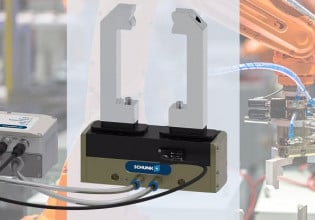Understanding RMS and True RMS for Meters and Mechanical Measurements
Electrical and mechanical measurements are often labeled with "RMS" and "True RMS." Aside from the simple math definitions we learned in electronics class, why is this distinction actually important?
In the realm of electrical and mechanical measurements, the terms “RMS” (root mean square) and “True RMS” often surface, each holding a distinct significance in quantifying the characteristics of alternating current (AC) waveforms. This article aims to clarify these terms, exploring their definitions, differences, and the electrical and mechanical contexts in which they play pivotal roles.
RMS and True RMS
Root mean square (RMS) is a mathematical concept used to calculate the effective value of an AC waveform. It represents the equivalent direct current (DC) value that would produce the same power dissipation or conversion effect in a circuit as an AC waveform. When given a sinusoidal waveform, the RMS value is approximately 70% of the peak value.

Figure 1. Graphical representation of a sinusoidal (AC) waveform with an equivalent RMS (DC) value. Image used courtesy of Simcenter Testing
RMS is particularly useful when dealing with complex waveforms that deviate from the ideal sinusoidal pattern. By providing a single value that accounts for the varying amplitude of the waveform over time, RMS allows for simplified calculations and accurate assessments of power and voltage.
While RMS is a valuable metric, it assumes that the waveform being measured is sinusoidal. In reality, many AC waveforms are far from being perfect sine waves, featuring harmonics and distortions. Additional components in the systems, such as appliances, computers, drives, batteries, etc., also contribute to the noise of the signal. True RMS takes the accuracy of RMS a step further by providing an accurate measurement of the actual effective value of any AC waveform, regardless of its shape.
True RMS meters utilize sophisticated circuitry to calculate the square root of the average of the squares of instantaneous values of a waveform. This method ensures precise measurements for both sinusoidal and non-sinusoidal waveforms, making True RMS essential in scenarios where waveform distortions are common.

Figure 2. Examples of the various types of non-sinusoidal waves. These waves can be further irregular with noise and distortions. A true rms calculation will effectively provide the equivalent DC value for all these waves. Image used courtesy of Wikipedia
Key Differences Between RMS and True RMS
- Applicability to Non-Sinusoidal Waveforms
- RMS is suitable for sinusoidal waveforms and provides an accurate representation of their effective value.
- True RMS is designed to accurately measure the effective value of both sinusoidal and non-sinusoidal waveforms, making it more versatile in real-world applications.
- Circuitry and Accuracy
- RMS meters typically assume a sinusoidal waveform and use simpler circuitry, providing accurate readings for ideal conditions.
- True RMS meters employ advanced circuitry to accurately calculate the effective value of complex waveforms, ensuring precision in diverse and distorted signal environments.
- Use Cases
- RMS is commonly employed in situations where the waveform is expected to be close to sinusoidal, such as in power distribution and basic electrical measurements.
- True RMS is indispensable in applications where non-sinusoidal waveforms are prevalent, including audio electronics, variable frequency drives, and other systems with distorted signals.

Figure 3. Typical error values for normal RMS measurement compared to True RMS calculation for various waveforms. Image used courtesy of Fluke
Voltage and Current Meters
Voltage and current meters are indispensable tools for engineers, technicians, and hobbyists alike, providing a convenient means to measure various electrical parameters. However, the distinction between root mean square (RMS) and True RMS labeling on meters is not merely a technical detail but a critical factor influencing measurement accuracy.
Real-world conditions are rarely ideal. Meters labeled with True RMS are more resilient in non-ideal conditions, offering accurate readings even in environments with distorted or complex waveforms. Accurate measurements are crucial for ensuring the safety and reliability of electrical systems. Using a True RMS multimeter provides a more comprehensive understanding of the actual electrical parameters, minimizing the risk of miscalculations and potential safety hazards.

Figure 4. Typical multimeter with “True RMS” labeling just below the function selection dial. Image used courtesy of Promax
When selecting a meter, understanding the nature of the electrical signals you will be measuring is paramount. If your work involves non-sinusoidal waveforms or applications where accuracy is paramount, investing in a True RMS multimeter is a wise choice. While True RMS meters may be slightly more expensive, their versatility and accuracy make them an invaluable tool for professionals working in diverse electrical environments.
RMS in Mechanical Measurements
Root Mean Square is a crucial metric in mechanical motion analysis, especially when it comes to vibration and acceleration measurements. In the context of mechanical systems, RMS is used to quantify the amplitude and intensity of vibrations, providing valuable insights into the dynamic behavior of structures and machinery.
Vibration Analysis
In vibration analysis, the primary focus is on capturing the amplitude of vibrational motion. RMS is employed to calculate the root mean square value of the vibration signal. The RMS value provides a measure of the effective amplitude of the vibration signal, taking into account both positive and negative excursions. This is particularly important in dynamic systems where vibrations fluctuate over time.
Beyond amplitude, RMS is used to represent the overall energy content of the vibration signal. Unlike peak values, which might be influenced by isolated spikes, RMS provides a more representative measure of the system's vibrational energy. The use of RMS in vibration analysis helps in characterizing the intensity of vibrations and understanding their potential impact on the structural integrity of machinery or buildings.
Engineers often compare RMS values of vibration signals over time or across different components of a system. This allows for the identification of trends, irregularities, or potential issues. By analyzing RMS values, engineers can assess whether vibrations are within acceptable limits or if there is a need for maintenance or further investigation.
Acceleration Measurements
In applications where acceleration is a key parameter, such as in vehicles or industrial machinery, RMS is used to calculate the root mean square acceleration. RMS acceleration provides a measure of the effective acceleration level, accounting for variations in acceleration over time. It is particularly relevant in assessing the overall intensity of dynamic motion.
RMS acceleration values are instrumental in predictive maintenance strategies. Sudden increases in RMS acceleration may indicate potential issues, allowing for proactive maintenance before a critical failure occurs. Structural health monitoring systems leverage RMS acceleration to evaluate the health and integrity of structures over time. Unusual changes in RMS values can be indicative of structural degradation or damage.
Mechanical Units and Parameters
- Units: The units for RMS acceleration are typically expressed in meters per second squared (m/s²), representing the acceleration of a vibrating or accelerating object.
- Frequency Analysis: In addition to RMS, frequency analysis is often employed in vibration analysis. The combination of RMS and frequency analysis provides a comprehensive understanding of the vibrational characteristics, allowing for targeted interventions and improvements.
Comparing RMS vs. True RMS Measurements
RMS and True RMS should always be considered by engineers in both electrical and mechanical contexts. Underscoring the critical role these measurements play ensures accuracy, reliability, and safety across diverse applications, ultimately empowering professionals to make informed decisions in their respective fields.
Featured image used courtesy of Adobe Stock






